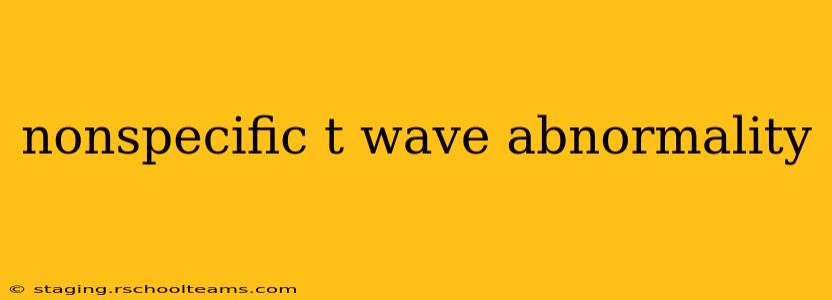A nonspecific T-wave abnormality (NSTWA) is a common electrocardiogram (ECG) finding that indicates a deviation from the normal T-wave morphology without a clear-cut diagnosis. This means the T-waves on the ECG show changes, but these changes aren't definitively linked to a specific heart condition. Understanding what constitutes a nonspecific T-wave abnormality, its potential causes, and the importance of further investigation is crucial for both healthcare professionals and patients.
What are T-Waves and Why are They Important?
The T-wave represents the repolarization of the ventricles—the powerful pumping chambers of the heart. During this phase, the heart muscle cells are recovering after contraction, preparing for the next heartbeat. The shape and amplitude (height) of the T-wave provide valuable information about the electrical activity of the heart. Normal T-waves are typically upright (pointing upwards) and relatively symmetrical.
Defining a Nonspecific T-Wave Abnormality
An NSTWA is characterized by deviations from the norm that don't fit into established patterns associated with specific cardiac conditions like acute coronary syndrome (ACS), hyperkalemia, or Brugada syndrome. These deviations can include:
- T-wave inversion: The T-wave points downwards instead of upwards.
- T-wave flattening: The T-wave loses its normal amplitude, appearing flatter and less prominent.
- T-wave asymmetry: The T-wave becomes asymmetrical, lacking its usual smooth, rounded appearance.
- Notched T-waves: The T-wave displays indentations or notches along its contour.
It's crucial to emphasize that the presence of an NSTWA alone does not automatically indicate a serious heart problem. Many factors can contribute to these variations, and further investigation is often necessary to determine the underlying cause.
Potential Causes of Nonspecific T-Wave Abnormalities
The range of possible causes contributing to an NSTWA is broad and can include:
Benign Causes:
- Normal variation: Slight T-wave variations are common and often fall within the normal range of individual variability. Age, sex, and physiological factors can influence T-wave morphology.
- Electrolyte imbalances (mild): Minor fluctuations in electrolytes like magnesium or calcium can subtly affect T-wave appearance.
- Increased vagal tone: Increased parasympathetic activity can lead to minor T-wave changes.
- Athletic heart: Highly trained athletes often exhibit ECG changes, including altered T-waves, due to cardiac adaptations to training.
- Certain medications: Some medications can impact the electrical activity of the heart, leading to nonspecific T-wave changes.
Potentially Significant Causes Requiring Further Evaluation:
- Myocardial ischemia (lack of blood flow to the heart muscle): While significant ischemia typically produces more specific ECG changes, subtle ischemia can sometimes manifest as an NSTWA.
- Myocarditis (inflammation of the heart muscle): Inflammation of the heart muscle can alter the electrical conductivity, potentially resulting in T-wave abnormalities.
- Early repolarization: This is a benign condition where early repolarization of the ventricles causes subtle T-wave changes, often seen in young, healthy individuals. However, it can sometimes be difficult to distinguish from other more serious conditions.
- Left ventricular hypertrophy (enlarged left ventricle): An enlarged left ventricle can lead to changes in the ECG, including T-wave alterations.
- Right ventricular hypertrophy (enlarged right ventricle): Similar to left ventricular hypertrophy, this can also cause ECG changes that may manifest as NSTWA.
The Importance of Clinical Correlation
The key to interpreting an NSTWA lies in clinical correlation. The ECG finding must be considered alongside the patient's symptoms, medical history, physical examination, and other laboratory tests. A healthy individual with an NSTWA on an otherwise normal ECG might require no further investigation. However, a patient experiencing chest pain, shortness of breath, or other symptoms suggestive of heart disease needs thorough evaluation.
Further Investigations
Depending on the clinical context, further investigations might include:
- Cardiac enzymes: To assess for myocardial damage.
- Echocardiogram: To visualize the heart's structure and function.
- Stress test: To evaluate the heart's response to exercise or pharmacological stress.
- Coronary angiography: To visualize the coronary arteries and identify any blockages.
Disclaimer: This information is intended for educational purposes only and should not be considered medical advice. Always consult with a qualified healthcare professional for any concerns about your heart health. They can properly interpret your ECG and determine the appropriate course of action based on your individual circumstances.
